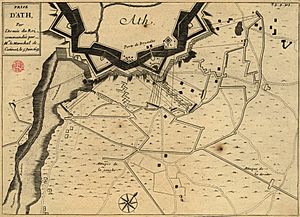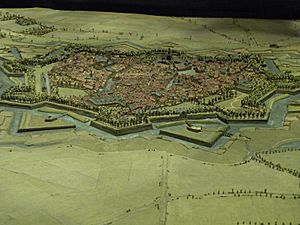Siege of Ath (1697) facts for kids
Quick facts for kids Siege of Ath (1697) |
|||||||
|---|---|---|---|---|---|---|---|
| Part of the Nine Years' War | |||||||
 Engraved map of the siege of Ath in 1697 |
|||||||
|
|||||||
| Belligerents | |||||||
| Commanders and leaders | |||||||
| Strength | |||||||
| 40,000 men 20,000 civilian laborers 34 siege guns 39 other guns 41 smaller artillery pieces |
3,850 men 32 artillery pieces |
||||||
| Casualties and losses | |||||||
| 200 killed and wounded | 3,700 killed, wounded and captured 32 artillery pieces captured |
||||||
The Siege of Ath was an important battle during the Nine Years' War in 1697. It took place in a town called Ath, which is now in Belgium. This siege showed how strong the French army was at the time.
The French army used a lot of supplies for the siege. They had huge amounts of gunpowder, lead, and thousands of cannonballs and mortar bombs. They also used many sandbags to build their defenses.
After the French won, about 6,000 workers helped fill in the trenches that had been dug. This victory, along with another French win in Barcelona, helped convince the other countries to sign a peace agreement called the Treaty of Ryswick. This treaty finally ended the war.
Many people at the time thought this siege was a masterpiece by a famous French engineer named Vauban. It was very fast and efficient, especially because the fortress of Ath had been designed by Vauban himself about 25 years earlier.
Contents
Why Was the Siege of Ath Important?
The War of the Grand Alliance started in 1688. The modern Spanish fortress of Ath was not a main target at first. The French armies of Louis XIV focused on bigger towns like Brussels and Oudenarde. Ath was a medium-sized town with about 6,000 people.
Peace talks to end the war began in 1695 in Ryswick. But since neither side had won a clear victory, the fighting continued. When the Duchy of Savoy left the Grand Alliance in late 1696, King Louis XIV of France decided it was time to win a big battle.
In April 1697, French forces started their campaign. They prepared to attack the strong fortress of Ath. This was meant to show the other countries how powerful France was, hoping it would make them agree to peace terms.
How Was Ath Fortified?
Ath's old medieval walls were improved by the Spanish in 1540. But when the French captured the fort in 1667, the Spanish soldiers ran away without a fight. The French, led by Vauban, then tore down the old walls in 1668.
From 1668 to 1674, Vauban built new, modern defenses. He created eight new angled bastions using a style called trace italienne. In 1678, the modern fort was given back to the Spanish as part of the Treaties of Nijmegen.
Key Features of Ath's Defenses
- Walls and Ditches: The main wall, called a curtain wall, was surrounded by a deep ditch. From the bottom of the ditch, the wall was 30 feet high. A special gate could raise the water level in the ditch by eight feet.
- Bastions: The bastions were strong, angled parts of the wall. They were close enough for soldiers to shoot at attackers from different angles.
- Outworks: In front of the bastions were chevron-shaped outworks called tenailles. Even further out were large, triangular ravelin islands. These islands had stone walls and could hold many soldiers and small guns.
- Outer Perimeter: The outer wall of the ditch was called the counterscarp. This served as a covered walkway around the fort. It was about 120 feet beyond the ravelins.
- Sloped Ground: The final part of the outer defense was a sloped area called a glacis. This slope made it very hard for attackers to approach. Defenders had clear shots from above, and there were two lines of wooden palisades at the top of the slope.
A journal from that time called Vauban's design a "perfect model of the Art." Vauban himself had thought about how to attack the fort ever since he designed it.
Who Led the Armies?
The French forces were led by Marshal Nicolas Catinat and his chief engineer, Marshal Vauban. They worked very well together. Catinat had about 40,000 men, including 50 battalions and many squadrons of cavalry. Vauban had 62 skilled engineers helping him.
Two other French Marshals, Boufflers and Villeroi, commanded separate armies. Their combined strength was about 140,000 men, and they protected Catinat's main force.
The Allied soldiers defending Ath numbered about 3,850 men. Their commander was the 65-year-old Comte de Roeux. He was often slow to act, so the real command usually fell to Anthony Günther, Prince of Anhalt-Zerbst. The Allies had focused on defending bigger forts like Brussels, so they were surprised when the French attacked Ath.
The Siege Begins
On the morning of May 16, a French cavalry force of 12,000 men arrived at Ath. They quickly took control of all roads, river crossings, and buildings nearby. Catinat's main army arrived the same day and set up three camps about 10 kilometers from the fortress.
The camps were separated by the two branches of the River Dender, which meet at Ath. The French immediately started building siege lines and bridges to make it easier to move around. The armies of Boufflers and Villeroi took positions on Catinat's sides to protect his forces.
First Moves by Both Sides
- Civilians Leave: Wealthy women inside the fort were allowed to leave by the French on the first day.
- Allied Actions: On May 17, the Allied soldiers inside the fort burned down buildings outside the walls. They did this to prevent the French from using them for cover. However, they forgot to burn down hedges and gardens, which the French later used. The Allied cannons also fired at the French camps, but they were too far away to hit anything.
- Vauban's Observation: Vauban noticed these mistakes and realized that the Allied governor, Roeux, was not a good commander.
Preparing for the Attack
The French brought in civilian surgeons from nearby cities like Valenciennes and Cambrai to help treat wounded soldiers. They also needed 4,000 wagons to carry supplies and weapons, so they hired civilian drivers from the area.
About 20,000 farmers were ordered to help dig long lines of circumvallation. These were trenches built to protect the French army from attacks by the soldiers inside the fort or by any Allied relief forces trying to help Ath.
The Main Attack
On May 22, Catinat and Boufflers inspected their armies. At 7:00 PM, the French began digging their first parallel trench. This trench was dug against the eastern side of the town, about 650 paces away from the fort.
What Happened After the Siege?
After the French won, the soldiers defending Ath were not given the usual honors of war. Instead, they were all taken prisoner.


